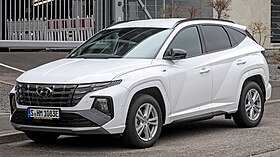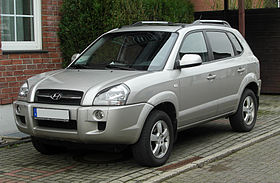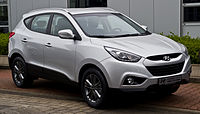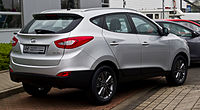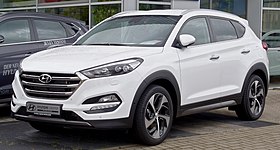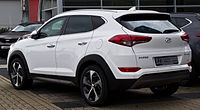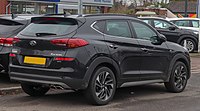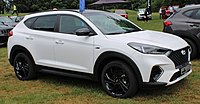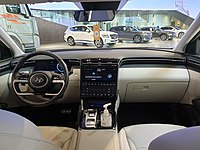
The Škoda Superb is a mid-size/large family car (D-segment) that has been produced by the Czech car manufacturer Škoda Auto since 2001.

The Kia Sportage is a series of automobiles manufactured by the South Korean manufacturer Kia since 1993 through five generations. Initially a compact SUV built on a body-on-frame chassis, the second-generation Sportage transitioned to a car-based platform which placed it into the compact crossover SUV class, and has been developed alongside the Hyundai Tucson. Since the fifth-generation model launched in 2021, Kia developed the Sportage in two sizes with different wheelbase lengths for different markets.

The Hyundai Elantra, also known as the Hyundai Avante, is a compact car produced by the South Korean manufacturer Hyundai since 1990. The Elantra was initially marketed as the Lantra in Australia and some European markets. In Australia, this was due to the similarly named Mitsubishi Magna Elante model; similarly, in other markets, the name Avante is not used due to its similarity with Audi's "Avant" designation, which is used for their line-up of station wagons. The name was standardized as "Elantra" worldwide in 2001.

The Hyundai Sonata is a mid-size car that has been manufactured by Hyundai since 1985. The first generation Sonata, which was introduced in 1985, was a facelifted version of the Hyundai Stellar with an engine upgrade, and was withdrawn from the market in two years due to poor customer reaction. While the nameplate was originally only sold in South Korea, the second generation of 1988 was widely exported.

The Kia Rio is a subcompact car manufactured by Kia from 1999 to 2023. Body styles have included a three and five-door hatchback and four-door sedan, equipped with inline-four gasoline and diesel engines, and front-wheel drive.

The Suzuki Vitara is a series of SUVs produced by Suzuki in five generations since 1988. The second and third generation were known as the Suzuki Grand Vitara, while the fourth generation eschewed the "Grand" prefix. In Japan and a number of other markets, all generations have used the name Suzuki Escudo.

The Hyundai Accent, or Hyundai Verna is a subcompact car produced by Hyundai. In Australia, the first generation models carried over the Hyundai Excel name used by the Accent's predecessor. The Accent was replaced in 2000 by the Hyundai Verna in South Korea, although most international markets, including the US, retained the "Accent" name. The "Accent" name is an abbreviation of Advanced Compact Car of Epoch-making New Technology.

The Kia Carnival is a minivan manufactured by Kia since 1998. It is marketed globally under various nameplates, prominently as the Kia Sedona.

The Kia Sorento is a lineup of sport utility vehicles manufactured by the South Korean manufacturer Kia since 2002 through four generations. Initially a compact SUV built on a body-on-frame chassis, the second-generation Sorento transitioned to a larger car-based platform which placed it into the mid-size crossover SUV class, and has been developed alongside the Hyundai Santa Fe.

The Nissan X-Trail is a compact crossover SUV produced by the Japanese automaker Nissan since 2000. Since its introduction, the X-Trail is positioned below the truck-based Xterra and Pathfinder.

The Hyundai Santa Fe is an automobile produced by the South Korean manufacturer Hyundai since 2000. It is a five-door crossover SUV that either has front-wheel drive or four-wheel drive. It is named after the city of Santa Fe, New Mexico, and was introduced for the 2001 model year as Hyundai's first SUV. The Santa Fe was a milestone in the company's restructuring program of the late 1990s because the SUV was a hit with American buyers. Between 2006 and 2012, the Santa Fe was positioned between the smaller Tucson compact crossover and the larger Veracruz. As of 2018, it is positioned between the Tucson and the larger Palisade.

The Mitsubishi Pajero is a full-size SUV manufactured and marketed globally by Mitsubishi over four generations — introduced in 1981 and discontinued in 2021.

The Opel Antara is a compact crossover SUV which was marketed by Opel from 2006 to 2015. Based on the Theta platform, the Antara closely shared its underpinnings and powertrains with the Chevrolet Captiva. However, it only offered five seats instead of seven, and features a different exterior and interior design. Sales commenced in November 2006, as the indirect successor to the Isuzu-based Frontera range.

The Hyundai i30 is a small family car manufactured by the South Korean manufacturer Hyundai Motor Company since 2006. The i30 shares its platform with the Kia Ceed, available as a three-door hatchback (2012–2017), five-door hatchback, five-door estate and five-door liftback (2017–present), with a choice of three petrol engines and two diesel engines, either with manual or automatic transmission.

The Hyundai Creta, also known as Hyundai ix25 in China, is a subcompact crossover SUV produced by Hyundai since 2014 mainly for emerging markets, particularly BRICS. It is positioned above the Venue and below the Tucson in Hyundai's SUV line-up.

The Hyundai Kona is a subcompact crossover SUV produced by the South Korean manufacturer Hyundai. The first-generation Kona debuted in June 2017 and the production version was revealed later that year. It is positioned between the Venue or Bayon and the Tucson in Hyundai crossover SUV line-up. The battery electric version called the Kona Electric was first launched in South Korea during the first half of 2018 and rolled out gradually worldwide afterwards.

The Hyundai ix35 is a compact crossover SUV produced by Beijing Hyundai while the predecessing Hyundai Tucson was sold in China alongside as a cheaper alternative next to the Hyundai ix35. The ix35 name was introduced by Hyundai in 2009 with the launch of the second generation Tucson crossover, but only outside South Korea and North America. From 2015, with the introduction of the third generation model, the model was again sold as the Tucson. In China, Beijing Hyundai kept the ix35 as an independent model, due to its high demand. As a result, the Tucson and ix35 crossovers were sold alongside in the same market.
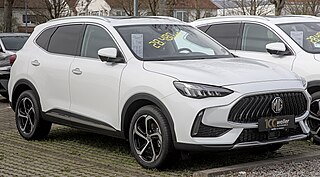
The MG HS is a compact crossover SUV manufactured by Chinese automobile manufacturer SAIC Motor under the British MG marque. The vehicle was launched in 2018, replacing the MG GS. It is bigger than the ZS but approximately the same size as the later MG One.

The Hyundai Venue is a subcompact crossover SUV manufactured by South Korean manufacturer Hyundai. The Venue debuted at the 2019 New York International Auto Show as Hyundai's smallest global crossover, prior to the introduction of other smaller SUVs such as the Casper and Exter.

The Kia Seltos is a subcompact crossover SUV manufactured by Kia. Introduced in mid-2019, the Seltos is positioned between the smaller Stonic, Soul, or Sonet and the larger Sportage in Kia's global SUV lineup.
